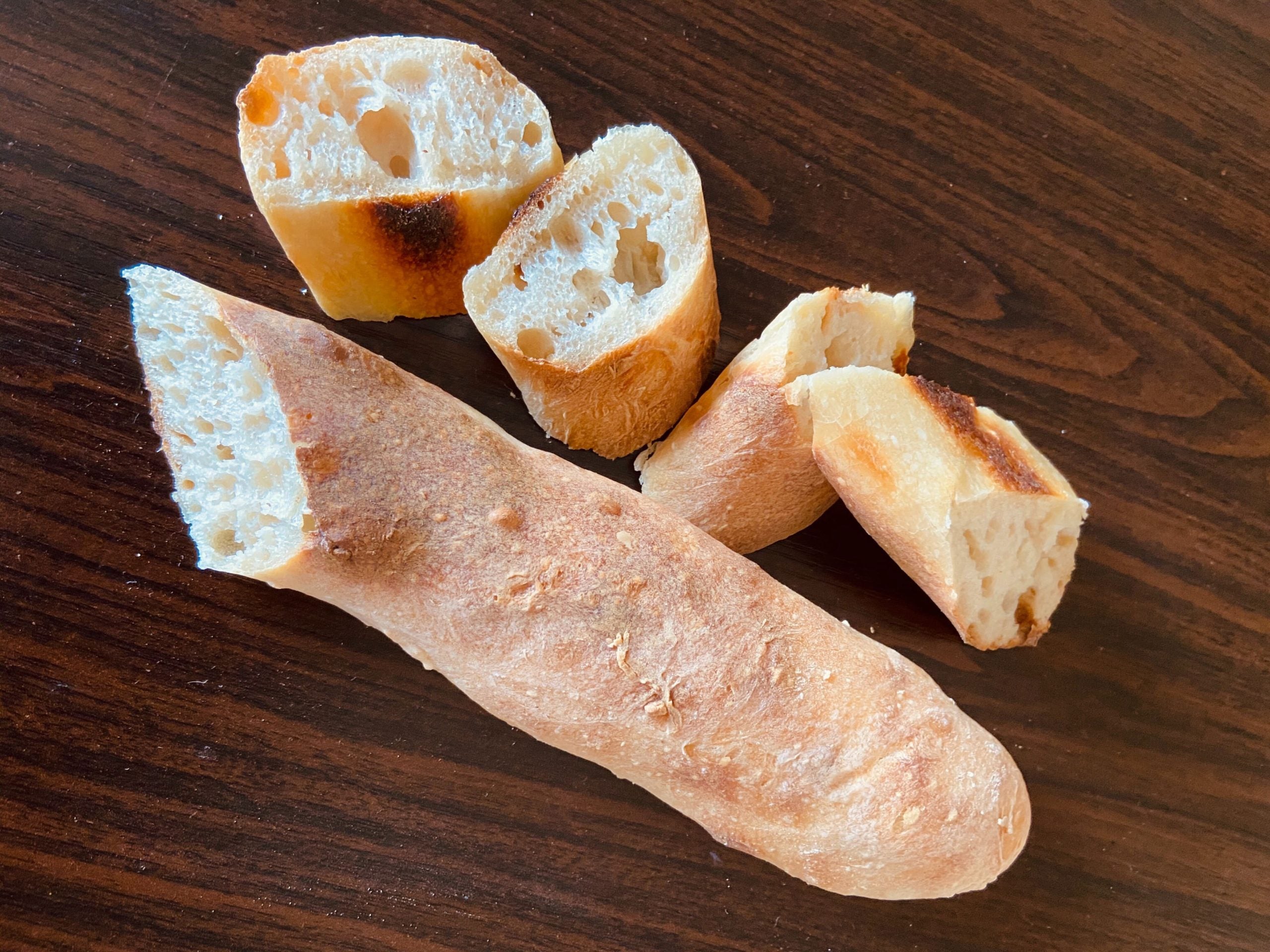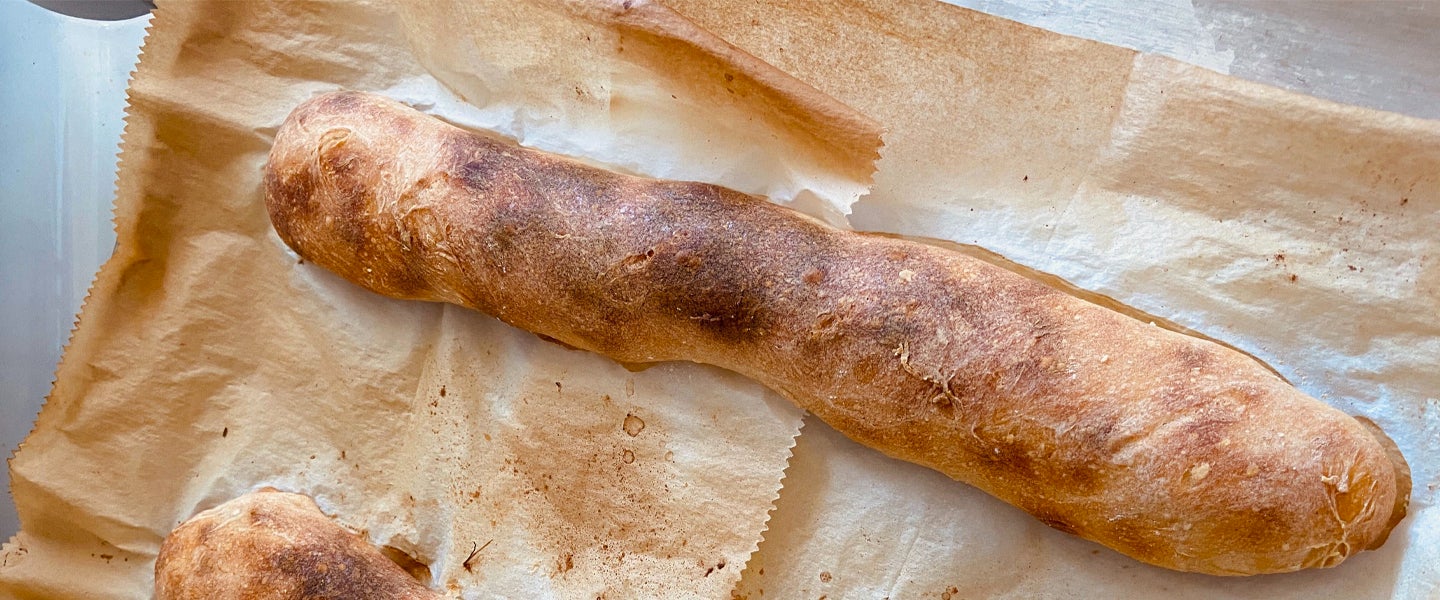I miss going to bakeries.
I miss staring into those long glass cases full of croissants that crackle under the press of a fingertip. I miss oohing and ahhing at the whole-wheat country loaves made by hands that know, without hesitation, what they’re doing. I miss kouign-amanns and napoleons and Danishes and pillowy Mexican conchas dappled with sugary frosting. And, most of all, I miss a good-ass baguette.
I miss it because I’m not a baker at heart (behind a hot stove is where I feel most at home), and it was always so easy to leave great bread to the pros in L.A. Besides, even if I could bake, pulling off a French baguette still kinda seems insurmountable — it’s supposed to be unforgiving, time-consuming and the territory of hardcore bread perfectionists.
But what if the reputation of the baguette is overblown? Could I have my own Ratatouille moment with a “symphony of crackle,” or would I emerge from the kitchen as a failure, holding up a baseball bat of doughy, splotchy gluten?
Energized by visions of making a Parisian ham-and-butter sandwich on a golden homemade loaf, I took to the internet to figure out what the best home recipes suggest. The good news is that the dough for a baguette-like bread is extremely simple to make (like many other breads, it’s just flour, water, salt and yeast). In fact, the only thing that makes it exceptional is the rising and shaping method, which normally involves a series of choreographed folds and rolls that can get messy in clumsy hands.
Others, like journalist and food YouTuber Adam Ragusea, forgo shaping altogether. His incredibly easy “legate loaf” recipe involves just making a very wet, no-knead bread dough that ages in the fridge. Once it’s ready, the loaf requires no shaping other than stretching and slapping it down onto a baking tray for a short rise. Then it goes into a hot oven, which Ragusea sprays with a bottle of water to create hot steam, replicating the effects of a commercial steam-injection bread oven.
This is a really smart alternative to putting a tray of hot water under the bread, which many recipes call for, and the result is tender bread with a thin, glossy crust. One big caveat, though: I’m not a huge fan of how flat the “legate loaf” can be, given its lack of structured shaping. But there seemed to be a compromise here — and I realized just what it could be after watching an older video from YouTube cooking legend Chef John.
My version makes two “demi”-sized loaves and requires just a regular half-sheet pan, parchment paper and a spray bottle of water. Combine 1/4 teaspoon instant yeast (add a tiny pinch more if you’re using active dry) with 3/4 cup of room-temperature water (175 grams) and a teaspoon of salt. Add in 2 cups (250 grams) of either bread or all-purpose flour, and begin mixing it with the handle of a wooden spoon or another stiff tool. The dough should start to glisten as you mix, with no major dry spots after a minute or so — if you see any, hit it with a spritz of water from your spray bottle. Keep moving the mixture until it pulls away from the walls of the bowl and becomes a shaggy, sticky ball.
Take your bowl, cover it with plastic wrap and let it either hang out for 12 hours at room temperature (inside the shelter of a turned-off oven, for me) or just stick it into the fridge and let it age until you need it. The flavor will begin to mature, almost like a sourdough, the longer it stays refrigerated, up to a week. I went with an overnight rest, and by the next morning, the dough had doubled in size and formed lots of bubbles.
Next, dump this mix onto a well-floured work surface. Flour your hands gently and pat the mix into a rough rectangle, then cut it in two. Lay a piece in front of you, and fold the top and bottom edges of the dough into the center, forming a cylinder with a seam down the middle. With a light touch from the palm of your hands, roll this chubby cylinder outward, using your fingers to keep the shape even and smooth out the seam. Repeat this with the other piece of cut dough. The dough will be extremely sticky, but be very sparing with the flour you sprinkle — if it gets too dry, you’ll be left with stiff bread.
Put parchment paper on your baking sheet and gently transfer your loaves onto it. Spritz the top with water and let it sit out for about 60 to 90 minutes to proof, until they swell to about double the size. If you want, use a razor blade and slice four diagonal lines into the top of the loaves to create a design and help the crust crack attractively.
Finally, heat the oven to 550 degrees, and when the loaves look ready, place them into the oven and quickly spray all the walls with water to create a cloud of steam. You’re going to repeat the spray step every 2 or 3 minutes for the first 10 minutes of cooking time. This helps the crust stay tender while the interior of the bread bakes, and will create a more attractive-looking color on the loaves, too.
The loaves should be done baking after about 15 to 20 minutes — you’re looking for the crust to go from splotchy brown-and-blond to golden amber.

And to my shock, after all these years of avoiding this recipe, I’ve realized that my rustic little homemade baguettes really do hit the spot in a way that supermarket bread simply will not. The aroma was intoxicating, and I could hardly wait for the loaves to cool as I poked and prodded the crust, listening for that crackle. And the flavor you get from letting dough hang out and knead itself over time is excellent, too. I ate half a loaf by myself with Boursin cheese, and the other half with French jam. Then I daydreamed about applying my success to a food truck where I just feed people minimalist sandwiches all day.
Such is the power of trying, doubting, and ultimately, succeeding at home to make things we’re not supposed to bother with. I still look forward to the day when I can eat baguettes and pastries made by hands that know the craft so much better than mine. But for now, I’m plenty impressed with what we can do at home — and why we probably should have never doubted it in the first place.

